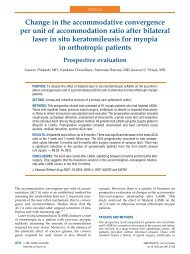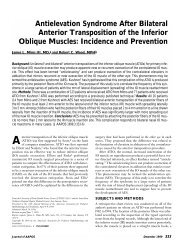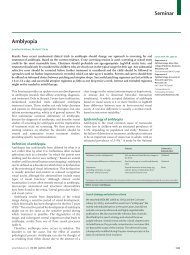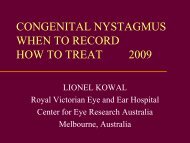What's new AAPOS 2008 - The Private Eye Clinic
What's new AAPOS 2008 - The Private Eye Clinic
What's new AAPOS 2008 - The Private Eye Clinic
Create successful ePaper yourself
Turn your PDF publications into a flip-book with our unique Google optimized e-Paper software.
STRABISMUS<br />
Causes and outcomes for patients presenting with diplopia to an eye casualty<br />
department.<br />
Comer RM, Dawson E, Plant G, Acheson JF, Lee JP.<br />
<strong>Eye</strong>. 2007 Mar;21(3):413-8<br />
Patients presenting with diplopia as a principal symptom, who were referred to the<br />
Orthoptic Department from Moorfields <strong>Eye</strong> Casualty over a 12-month period, were<br />
retrospectively investigated. One hundred and seventy-one patients were identified with<br />
complete records in 165 cases. <strong>The</strong>re were 99 men and 66 women with an age range of<br />
5-88 years. Monocular diplopia accounted for 19 cases (11.5%), whereas 146 patients<br />
(88.5%) had binocular diplopia. Cranial nerve palsies were the most common cause of<br />
binocular diplopia accounting for 98 (67%) of cases. Isolated sixth nerve palsy was the<br />
largest diagnostic group (n=45). Microvascular disease (hypertension or diabetes<br />
mellitus, or both) was present in 59% of patients with cranial nerve palsies, and of this<br />
group, 87% resolved spontaneously by 5 months rising to 95% by 12 months. Causes<br />
of binocular diplopia other than cranial nerve palsies included thyroid eye disease,<br />
myasthenia gravis, myositis, superior oblique myokymia and previous strabismus<br />
surgery. Patients with clinically isolated single cranial nerve palsies associated with<br />
diabetes or hypertension are likely to recover spontaneously within 5 months and<br />
initially require observation only. However, patients with unexplained binocular diplopia<br />
and those who progress or fail to recover should be investigated to establish the<br />
underlying aetiology and managed as appropriate.<br />
New approach for treating vertical strabismus: decentered intraocular lenses.<br />
Nishimoto H, Shimizu K, Ishikawa H, Uozato H.<br />
J Cataract Refract Surg. 2007 Jun;33(6):993-8.<br />
PURPOSE: To evaluate a <strong>new</strong> surgical procedure that uses a decentered intraocular<br />
lens (IOL) to correct vertical strabismus in cataract patients.<br />
METHODS: Six patients (11 eyes) with vertical strabismus had small-incision cataract<br />
surgery. <strong>The</strong> continuous curvilinear capsulorhexis was decentered, and the<br />
asymmetrical span of the IOL haptics located on the side to be bent was inserted after<br />
phacoemulsification and aspiration. Some relaxing incisions were made in the anterior<br />
capsule. Postoperatively, the alternate prism cover test was used to assess changes in<br />
ocular position. In addition, the EAS-1000 (Nidek) and KR-9000PW (Topcon) were used<br />
to evaluate IOL decentration, tilt, and aberrations.<br />
RESULTS: <strong>The</strong> mean age of the patients was 66 years (range 58 to 77 years). <strong>The</strong><br />
mean preoperative vertical strabismus was 7.3 prism diopters (PD) (range 4 to 12 PD).<br />
Two years after surgery, the mean angle of vertical deviation was 1.3 PD (range 0 to 5<br />
9
















